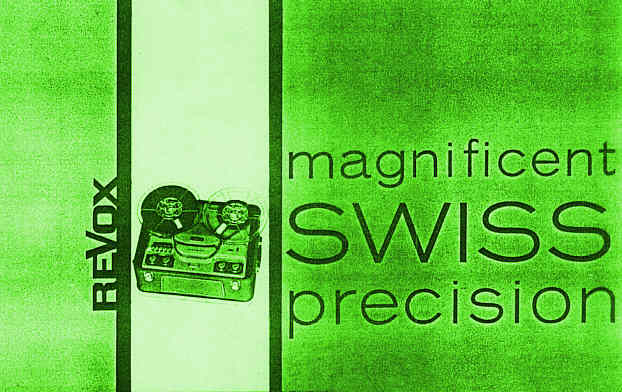
Revox F36

THE NATURAL-SCENIC BEAUTY and the age-old watchmaking craftmanship form only a part of the real Switzerland. Engineering also contributes to the country's activities and in this realm are to be found many small and medium-sized concerns whose sole aim is to produce articles of the highest quality in their respective fields. Their products are intended for the quality-minded buyer and they have no interest in competing against the mass-production combines. In this category lies the Studer Organisation.
In the early 1930's a young Swiss engineer, Willi Studer, commenced designing and building radios and electro-acoustic equipment in his spare time. From the very beginning it was only to pursue ultimate perfection that really interested him and he set out to produce only equipment of the highest quality. Soon he entered the manufacturing field, initially making specialised test and measuring instruments. Production of this type continues today.
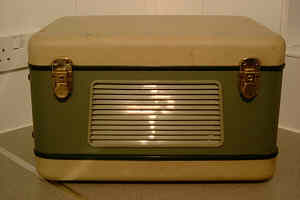
Commercial manufacture of tape recorders in Europe started in the late forties and at this time Willi Studer first turned his attention to producing a tape recorder for the amateur in place of the wire recorders that were current at that time. In 1951 the domestic, machine was first given the name Revox and continual development has resulted in the present F 36 Model, being the fulfilment of all the requirements of the enthusiast and the semi-professional user.
Such was the growth of the popularity of Revox machines that greatly increased production facilities were sought and in 1960 the firm moved to its present location in a new factory at Regensdorf, just outside Zurich. Here the considerable floor space available has enabled the Company to produce nearly all the small mechanical component parts thereby eliminating the delays often caused by subcontractors. In addition to the 36 Series machines and the. special measuring instruments, the factory have for some years been producing Studio and Broadcast Tape Equipment. Currently the C 37 model is universally regarded as the most advanced equipment of its type and already hundreds are in use in Broadcasting Stations and Recording Studios all over the world.
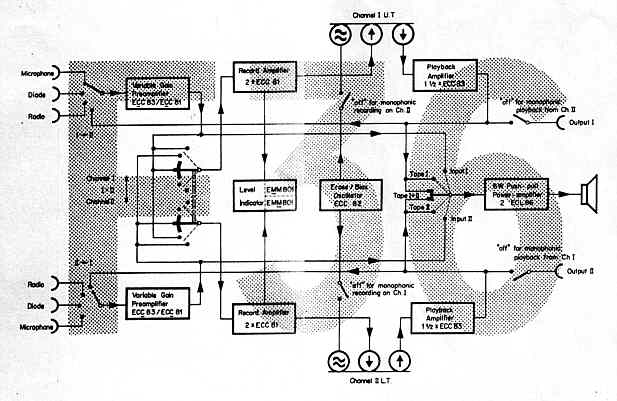
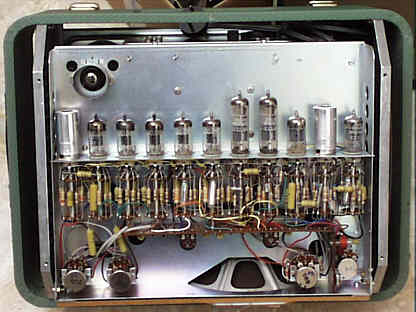
ELECTRONICS OF THE HIGHEST QUALITY are built into the Revox. The Revox is a mono/stereo machine. Further it has separate recording heads, separate playback heads; and fix audio pre-amplifiers as indicated in the block diagram. Separate channel control enables recordings to be made independent of one another. Additionally, one channel can be set to playback whilst the other is recording and all forms of multiplay and duoplay are possible. The mixing arrangements providing one pre-amplifier not in use for recording to be coupled with the other pre-amplifier through which the recording is being made with neither gain control acting as a master. Thus any two signals may be mixed and recorded in the mono mode. The monitor amplifier of the Revox gives a total of 6 watts output at less than 1% distortion. The extremely sensitive double trace magic eye enables both channels to be checked simultaneously and has an incredibly fast rise time which accurately registers peaks. (click here to see the photo enlarged )
THE HEAD AND THE TAPE TRANSPORT SECTION WHERE REVOX PUT YOUR RECORDING QUALITY INTO THE PROFESSIONAL CLASS.
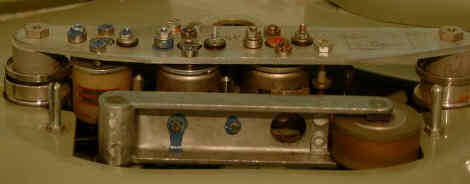
The tape is not held against the heads by the use of pads, but in the professional manner by arranging the heads in an arc. Result: less friction on the tape and much reduced and more even head wear. The end-of-tape stop is ingeniously provided during all functions, with or without the use of stop foils. The machine also stops immediately should the tape break or the mains fail momentarily. Note here the provision of three heads thus permitting the optimum performance to be obtained, and also the giant capstan-cum-flywheel bearing which is more than able to carry the high pressure exerted on it by the pinch roller. (click here to see the photo enlarged )
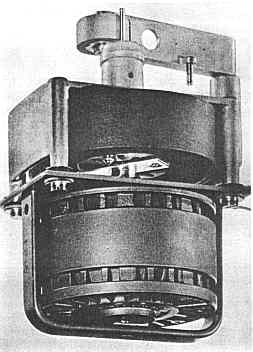
HEART OF TIHE REVOX AND YOUR ASSURANCE AGAINST WOW OR FLUTTER NOW OR LATER.
The huge capstan motor is coupled to the dynamically balanced flywheel by means of a special anti-vibration rubber disc. This effectively damps out all but the barest traces of flutter and permits piano recordings to be made at 3 3/4 i.p.s. in absolute safety. Two smaller Papst outer rotor motors are employed for winding and tensioning. So smooth is the operation that on fast tape handling you can actually switch from right to left (or vice versa) - no tape snatch, no tape spill, no breakage. The braking is mechanical with electrical control. Consequentially, braking is efficient, precise, immediate, and the machine always fails 'safe'. The use of solenoids throughout provides for effective remote control and the machine may be started or stopped in the record or playback functions at any distance.
EVEN THE REAR PANEL HAS BEEN DESIGNED FOR MAXIMUM CONVENIENCE especially for cabinet mounting
|
|
|
SPECIFICATION
|
Tape speed |
3 3/4 and 7 1/2 ips, pole-switching capstan motor, direct drive (motor may be switched off, if recorder is used as an amplifier) |
||
|
Flutter and wow |
below ± 0,1% at 7 1/2 ips |
||
|
Rewind time |
approx. 80 seconds of a 2400 feet reel |
||
|
Max. reeldiameter |
25 cm (10"), i.o. 3300 ft. long play tape |
||
|
Frequency response |
40 - 15'000 cycles at 7 1/2 ips +2/-3 db |
||
|
Equalization |
in accordance with CCIR standards. |
||
|
Signal to noise ratio |
Better than 50 db at peak record level |
||
|
Dynamic range (overall) |
2-track recorder: |
55 db at 7 1/2 ips |
|
|
53 db at 3 3/4 ips |
|||
|
4-track recorder |
52 db at 7 1/2 ips |
||
|
50 db at 3 3/4 ips |
|||
|
(Thd.= 3%) |
|||
|
Crosstalk |
Mono 55 db |
stereo 40 db |
|
|
Oscillator-bias frequency |
70'000 cycles, |
push-pull oscillator |
|
|
Inputs per channel |
1. microphone |
= 1 Megohm, 3 mV |
|
|
2. Radio |
= 1 Megohm, 50 mV |
||
|
3. Diode |
= 47 K'ohms, 3 - 50 mV, adjustable |
||
|
Outputs |
2 cathode-follower outputs, impedance = 5'000 ohms (input impedance of amplifier to be connected should be higher than 100'000 ohms. output voltage = 0.7 volts) |
||
|
Tube complements |
5 x ECC 81, 1 x ECC 82, 4 x ECC 83, 2 x ECL 86, 1 x EM 801, |
||
|
Power line voltage |
110, 240 volts, 50 cycles |
||
|
Power requirements |
approximately 120 watt |
||
|
Fuses |
for 220-240 volts: 0.6 Amps) 5 x 20 mm slow-blow |
||
|
All these data are valid for the 2-track as well as the 4-track recorder, unless noted otherwise. |
|||
|
|
|